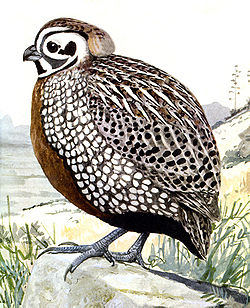| Cyrtonyx | |
|---|---|
 | |
| Cyrtonyx montezumae | |
| Scientific classification | |
| Kingdom: | Animalia |
| Phylum: | Chordata |
| Class: | Aves |
| Order: | Galliformes |
| Family: | Odontophoridae |
| Genus: | Cyrtonyx Gould, 1844 |
| Type species | |
| Ortyx montezumae Vigors, 1830 | |
Cyrtonyx is a bird genus in the New World quail family Odontophoridae.
The genus Cyrtonyx was introduced in 1844 by the English ornithologist and bird artist John Gould. [1] The name combines the Ancient Greek kurtos meaning "curved" and onux meaning "nail" or "claw". [2] The type species is the Montezuma quail (Cyrtonyx montezumae). [3]




